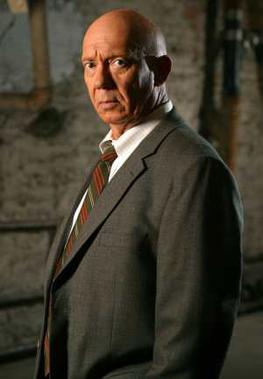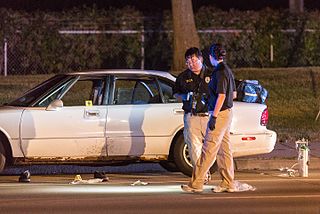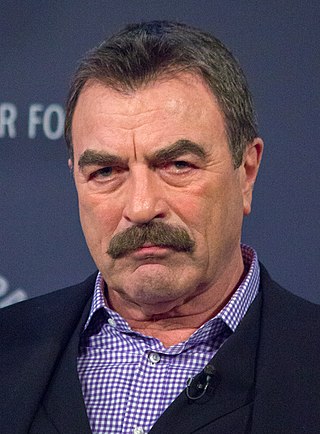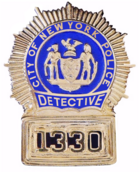A Special Victims Unit (SVU) or Special Victims Division is a specialized division within some police departments. The elite squad of detectives in this division typically investigate especially heinous crimes involving sexual assault or victims of non-sexual crimes who require specialist handling such as the very young, the very elderly, or the disabled.

The Philadelphia Police Department is the police agency responsible for law enforcement and investigations within the County and City of Philadelphia, Pennsylvania. The PPD is one of the oldest municipal police agencies, fourth-largest police force and sixth-largest non-federal law enforcement agency in the United States. Since records were first kept in 1828, at least 289 PPD officers have died in the line of duty.

Donald 'Don' Cragen is a fictional character played by Dann Florek in the American police procedural television series Law & Order and its spinoff, Law & Order: Special Victims Unit, on NBC. Cragen is a homicide captain with the New York Police Department who later becomes captain of the department's Special Victims Unit. A recovering alcoholic, Cragen is a tough police veteran who is loyal to his officers. He appeared in the first three seasons of Law & Order and in the first 15 seasons of Law & Order: Special Victims Unit. Having credited appearances in 400 episodes in the Law & Order franchise, Cragen has appeared in the third-most episodes of any character in the franchise; this mark is surpassed only by Olivia Benson and Fin Tutuola, main characters on Law & Order: Special Victims Unit.

John Munch is a fictional character played by actor Richard Belzer. Munch first appeared on the American crime drama television series Homicide: Life on the Street on NBC. A regular through the entire run of the series from 1993 to 1999, Munch is a cynical detective in the Baltimore Police Department's Homicide unit, and a firm believer in conspiracy theories. He is originally partnered with Detective Stanley Bolander. Munch is based on Jay Landsman, a central figure in David Simon's 1991 true crime book Homicide: A Year on the Killing Streets.

Olivia "Liv" Margaret Benson is a fictional character and the main protagonist of the NBC police procedural drama Law & Order: Special Victims Unit, portrayed by Mariska Hargitay. Benson holds the rank and pay-grade of Captain and is the Commanding Officer of the Special Victims Unit of the New York City Police Department, which operates out of the 16th Precinct. She investigates sexual offenses such as rape and child sexual abuse.

The Jacksonville Sheriff's Office (JSO) is a joint city-county law enforcement agency, which has primary responsibility for law enforcement, investigation, and corrections within the consolidated City of Jacksonville and Duval County, Florida, United States. Duval County includes the incorporated cities of Jacksonville, Atlantic Beach, Baldwin, Jacksonville Beach, and Neptune Beach; the beach cities have their own police departments as well.
The New York City Police Department's Medal for Valor is the department's third highest medal. It is conferred upon police officers for acts of outstanding personal bravery intelligently performed in the line of duty at imminent personal hazard to life under circumstances evincing a disregard for personal consequences.

The Pittsburgh Police (PBP), officially the Pittsburgh Bureau of Police, is the largest law enforcement agency in Western Pennsylvania and the third largest in Pennsylvania. The modern force of salaried and professional officers was founded in 1857 but dates back to the night watchmen beginning in 1794, and the subsequent day patrols in the early 19th century, in the then borough of Pittsburgh. By 1952 the Bureau had a strength of 1,400 sworn officers; in July 1985, 1,200; and by November 1989, 1,040.

The Behavioral Science Unit (BSU) is the original name of a unit within the Federal Bureau of Investigation's (FBI) Training Division at Quantico, Virginia, formed in response to the rise of sexual assault and homicide in the 1970s. The unit was usurped by the Critical Incident Response Group (CIRG) and renamed the Behavioral Research and Instruction Unit (BRIU) and currently is called the Behavioral Analysis Unit (5) (BAU-5) within the National Center for Analysis of Violent Crime (NCAVC). The BAU-5 currently works on developing research and then using the evidence-based results to provide training and improve consultation in the behavioral sciences—understanding who criminals are, how they think, why they do what they do—for the FBI and law enforcement communities.

The New York City Housing Authority Police Department was a law enforcement agency in New York City that existed from 1952 to 1995, which was then merged into the NYPD. The roots of this organization go back to 1934 and the creation of the New York City Housing Authority (NYCHA). New York City Mayor Fiorello H. La Guardia authorized the hiring of security guards to patrol the city's public housing buildings. These guards eventually were trained and became the first officers of the Housing Police, which was officially created in 1952. The Housing Police, along with the New York City Transit Police, was merged into the New York City Police Department in 1995 by New York City Mayor Rudy Giuliani and continues today as the Housing Bureau.
A major case squad is a division within some police departments. The detectives of these divisions typically investigate crimes beyond the scope of normal squads. These functions vary from department to department.
Akron Police Department is the primary municipal law enforcement agency for the city of Akron, Ohio, United States with 451 employees. The current Police Chief is Stephen L. Mylett.

The New York City Police Department (NYPD) is structured into numerous bureaus and units. As a whole, the NYPD is headed by the Police Commissioner, a civilian administrator appointed by the Mayor, with the senior sworn uniformed officer of the service titled "Chief of Department". The Police Commissioner appoints the First Deputy Commissioner as the department's second-in-command and the Chief of Department as the department's highest ranking uniformed officer. The commissioner also appoints a number of deputy and assistant commissioners who do not have operational command and are solely for support and administrative function. The department is divided into twenty bureaus, six of which are enforcement bureaus. Each enforcement bureau is further subdivided into sections, divisions, and units, and into patrol boroughs, precincts, and detective squads. Each bureau is commanded by a bureau chief. There are also a number of specialized units that are not part of any of the bureaus and report to the Chief of the Department.
The Columbia Police Department (CPD) is the principal law enforcement agency serving the city of Columbia, Missouri in the United States. It protects a metropolitan population of nearly 127,000 with 187 sworn police officers.

Crime in Minnesota encompasses a wide range of unlawful activities that occur within the state, regulated by both state and federal laws. While crime rates in Minnesota are generally below the national average, certain areas and types of crime have garnered public attention.
The Organized Crime Control Bureau (OCCB) was one of the ten bureaus that formed the New York Police Department. The Bureau was charged with the investigation and prevention of organized crime within New York City. The OCCB was disbanded in March 2016 with all investigative entities moved to the Chief of Detectives' office. The reason for this was the NYPD launching a major reshuffle of its investigative forces, consolidating several of them in an effort to tackle the city's biggest crime problem — violence by gangs and youth crews.

Albert A. Seedman was an officer with the New York City Police Department (NYPD) for 30 years, known for solving several high-profile cases before resigning as chief of the Detective Bureau. He was the only Jewish officer to ever hold that position. After his retirement he was the chief of security for a New York area department store chain before retiring to South Florida.

Francis Xavier Reagan is a fictional character from the TV series Blue Bloods portrayed by Tom Selleck. In the series, Reagan is the New York City Police Commissioner, the son of a former Commissioner, and the patriarch of a family of police officers and others involved in aspects of the city's criminal justice system. Selleck's performance in the role has been critically praised, but the character has been criticized by some for presenting an overly positive view of law enforcement administration.











